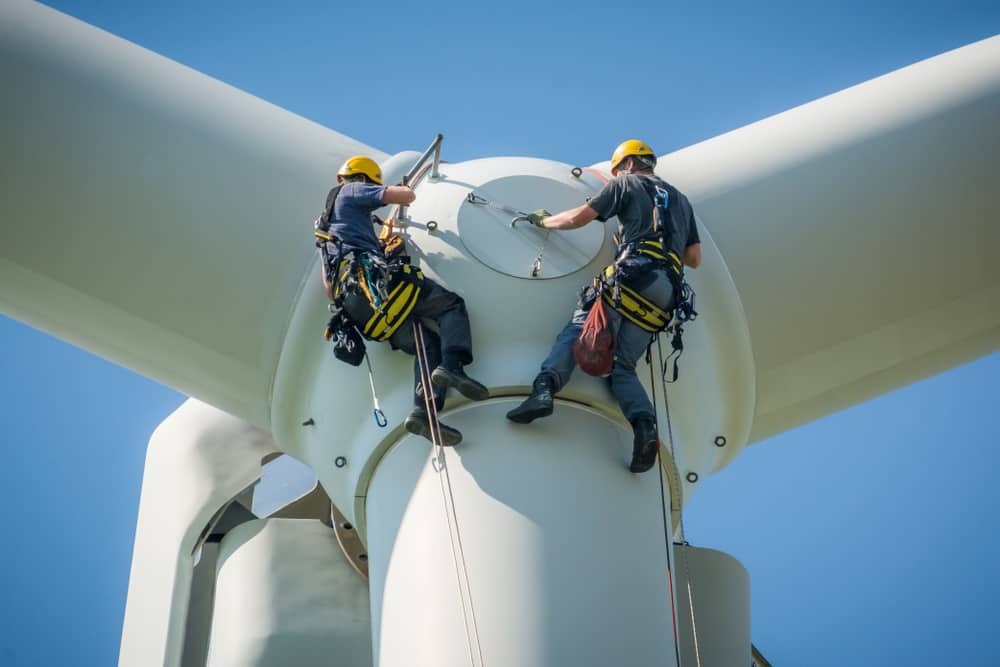Testing Wind Turbine Components: How NDT Improves Wind Energy Reliability
The increasing need for clean energy has increased interest from investors across the globe in renewable energy projects like wind farms. In 2020, wind energy will contribute 8% of the U.S.’s total electricity generation. However, to improve the consumer reliability of wind energy and increase the number of projects, it is also necessary to ensure that the existing wind turbines and their components function correctly to provide a longer service life.
Wind turbines used for utility-scale electricity generation are complicated structures consisting of many complex components, including turbine blades, busbars, rotors, shafts, gears, and other mechanical components. Enhanced inspection leveraging the advantages of nondestructive testing (NDT) can help guarantee the quality of these wind turbine components. By reducing risk and enhancing the operation of wind turbines, NDT can help wind be a dependable source for commercial energy use.
Wind Turbine Components and Its Assessment
Components of a wind turbine require a timely inspection to ensure structural integrity.
However, the flaws can be introduced in the components as early as during the manufacturing phase. The commonly observed defects include inclusion, delamination, micropitting, voids, cracks, corrosion, and lack of fusion in joints. During installation and operation, these flaws may further exacerbate under different stress and load conditions. A common example includes exposure to heavy wind and storm conditions which can severely damage the turbine blades. The time-varying nature of wind conditions also means the wind turbine components may be prone to fatigue, further increasing the chances of failure.
Technicians must be mindful of assessment procedures for composites, welds, and material inspection for possible surface and subsurface defects in wind turbine components. NDT methods such as ultrasonic testing (UT) and eddy current testing (ECT) have effectively identified these flaws and ensured the quality of wind turbine components.
| Learn all you need to know about Wind turbine non-destructive testing. |
NDT Minimizes Chances of Wind Turbine Failure
UT Inspection of Wind Turbine Components
Turbine blades usually have materials such as resins, fiberglass, and metals such as iron, steel, and aluminum. Delamination and cracks can be difficult to detect if they are hidden within the composite layers. Air bubbles and inclusions can be trapped within the fiber layers during the resin flow in the production process. The aerodynamic load can lead to the development of fatigue cracks, and corrosion can result from environmental conditions. In addition, complex blade geometry can present a challenge during scanning for conventional UT probes.
Additionally, weld defects in wind towers should be subjected to NDT inspection along with micropittings in gear teeth and bearings developed due to varying load, changing speed, and vibration.
Detection of these flaws during wind turbine inspection can be made easier with advanced UT techniques such as phased array ultrasonic testing (PAUT). Unlike conventional UT, PAUT provides customized beam focusing ability for technicians to send and receive signals along a range of angles in multiple directions. The improved probe sensitivity facilitates detection of all minor flaws that may be difficult to detect visually.
The high-frequency beam can easily analyze thicker welds and materials of attenuative nature. A comprehensive single-probe analysis ability can provide faster inspection, and high flexibility enables complex geometrical inspection.
ECT Inspection
ECT is most prominently used when inspecting key structural components such as busbars and gears for detecting surface and near-surface defects. The material composition, stress, temperature fluctuation, and mechanical use of these components dictate the extent of defect development. The advanced ECT technique such as Eddy Current Array (ECA) facilitates effective weld and material inspection to identify defects and discontinuities such as cracks, corrosion, and pits.
Unlike conventional ECT, multi-element ECA probes provide greater sensitivity and wider coverage in a single pass. With modern flexible and portable surface array probes, inspection on weld joints, contoured surfaces, and bent areas is made easy, such as curved wind turbine towers and bent areas in busbars. In addition, the provision for +point coils in ECA probes such as Zetec’s Surf-X Array facilitates flaw detection in hard to inspect areas.
The selection of the right instrument allows NDT inspectors to examine all critical wind turbine components with a greater probability of defect detection. Zetec’s compact and portable solutions can help with quick and accurate inspection to minimize the chances of wind turbine failure.
Quality Inspection Fosters Wind Energy Reliability
Regular inspection is a necessary measure to establish the quality of wind turbine components. ECA and PAUT techniques are effective in inspecting these components pre-service as well as during operation. Zetec’s ultrasonic and eddy current solutions, including MIZ-21C, Surf-X Flexible Array Probes, and TOPAZ provide flexibility in inspecting many types of materials and geometries in many locations. With enhanced sensitivity, analysts can easily deduce otherwise difficult to assess defects.
The complex structure of wind turbine components and varying loads means a greater probability of wear and tear and chances of structural failure. NDT of wind turbine components is thus extremely important to reduce the potential failure and downtime. With cost-effective and faster inspection options, it is possible to improve the reliability of wind energy as a prominent renewable energy option.
Zetec is a leading provider of advanced ECT and UT instruments that can help you inspect wind turbine components, including turbine blades, busbars, gears, and many more. To develop a custom NDT plan for wind turbine inspection needs, contact Zetec today.

